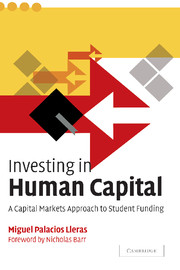Book contents
- Frontmatter
- Contents
- List of figures
- List of tables
- Foreword
- Acknowledgments
- Introduction
- Part I The problem of financing education
- Part II Equity-like investments to finance education
- 4 The evolution of human capital contracts
- 5 How human capital contracts work
- 6 The case for human capital contracts
- 7 Human capital options
- Part III Implementing human capital contracts
- Appendix A Valuation of human capital contracts
- Appendix B Using human capital options to value income-contingent loans
- Appendix C Features of human capital contracts, income-contingent loans, and traditional mortgage-type loans
- Appendix D A developing country study
- Notes
- References
- Index
7 - Human capital options
Published online by Cambridge University Press: 08 January 2010
- Frontmatter
- Contents
- List of figures
- List of tables
- Foreword
- Acknowledgments
- Introduction
- Part I The problem of financing education
- Part II Equity-like investments to finance education
- 4 The evolution of human capital contracts
- 5 How human capital contracts work
- 6 The case for human capital contracts
- 7 Human capital options
- Part III Implementing human capital contracts
- Appendix A Valuation of human capital contracts
- Appendix B Using human capital options to value income-contingent loans
- Appendix C Features of human capital contracts, income-contingent loans, and traditional mortgage-type loans
- Appendix D A developing country study
- Notes
- References
- Index
Summary
Chapters 1–6 explored human capital contracts (HCCs), the history of the idea, how they would operate, and the reasons why their introduction was desirable for higher-education financing. This chapter introduces an additional instrument that can further enhance the use of future earnings to improve higher-education financing. The introduction of this instrument is a new insight brought forward in this book, as it creates a different framework for analyzing and implementing income-contingent loans (ICLs). It builds on options theory, in particular on their use for valuing contingent claims, to analyze the valuation and sources of risk within ICLs. The instrument introduced here will be named a human capital option (HCO).
Understanding that the reader might not be familiar with the theory of financial options, the following section is a short introduction about these instruments, and shows how they can be useful, before describing the HCO in particular.
What is an option?
An introduction
The kinds of options referred to in this book are financial options. A financial option gives its owner the right to buy, or sell, an asset at a predetermined price on, or before, a predetermined date. The particular conditions attached to an option are part of the jargon used every day by option traders. The most important are defined below.
The creation of an option takes place when two parties sign a contract in which one party – the owner of the option – gets the right to buy or sell an asset from the other party – the writer of the option.
- Type
- Chapter
- Information
- Investing in Human CapitalA Capital Markets Approach to Student Funding, pp. 81 - 102Publisher: Cambridge University PressPrint publication year: 2004



